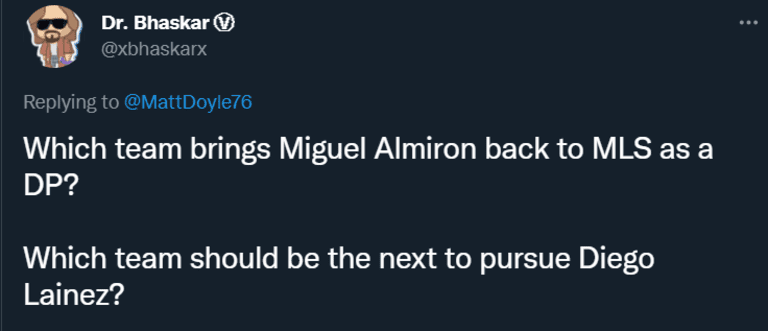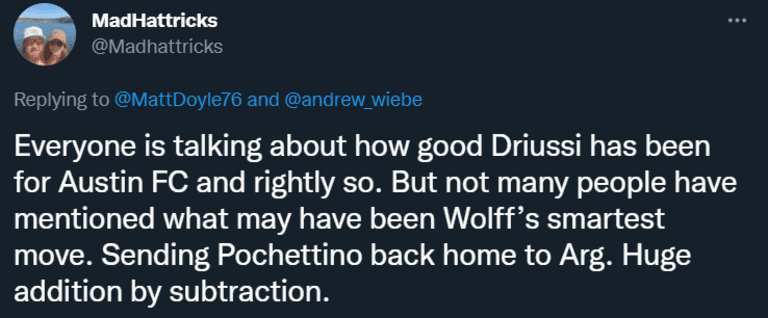No one loves doing a mailbag as much as a columnist who’s been doing the same job for a dozen years and sometimes has trouble coming up with new topics and angles.
Ahead we go. Answers to your most burning questions await!

For the past two months I’ve been writing that Atlanta United should back out of the Thiago Almada deal at the last minute and swerve toward giving Miggy (and Newcastle) an offer he can’t refuse to come home. This became more plausible this week when it was reported by various outlets that Almiron – whose contract runs until the summer of 2024 – is officially being shopped by the Magpies, who seem set for a biblical infusion of cash given their new owners have half the world’s oil.
Bringing Almiron home to Atlanta makes so much sense. He was arguably better for Paraguay when he played in MLS for one, and for two, Atlanta can almost certainly pay him better than any non-EPL team. And yes, he’s almost certainly going to have to go to an EPL team.
On-field, from Atlanta’s perspective, there is no downside. You know he fits, you know he’s durable enough to run the show in MLS, and you know he is the type of north-south, playmaking attacker who actually gets Josef Martinez to start making those off-ball runs that have rather distressingly faded from his game. There is no player on that roster I wouldn’t trade, straight-up, for Miggy.
But we all know it won’t happen because it doesn’t work like that. Atlanta brought in Luiz Araujo last year, and they brought in Almada this winter, and along with Josef, that’s their three DP slots taken (Almada makes too much to be a U22 Initiative guy). And short of buying one of those two guys out, which is extremely unlikely to the tune of less than 1%, or trading one, which is extremely unlikely to the tune of, I’ll say, less than 2%, there is no way to get Miggy back in The A.
But there is a clear way to get him back into MLS, and roughly 28 teams that could use him. I’m going to focus on two:
They are atop the Allocation Order and their ownership is one of the few groups I could see spending the likely eight-figure transfer fee it would take to get Miggy back into the league, and then meeting his salary demands.
He’d also be a hell of a fit for this team, which could go to a 4-2-2-2 with Almiron and Lucho Acosta inverted as right and left attacking midfielders, respectively. I think that would work very well for how Pat Noonan seems to want to get his team to play.
They will have one DP slot open soonish (Diego Rossi) and, potentially, another open this summer if Carlos Vela leaves. And I’ll be perfectly honest with you: If I were LAFC and had the choice between Vela and Almiron from this July til, say, 2026, I take Miggy without a second’s hesitation. Yes, he plays the position differently from Vela and no, he’s not as good as a fully fit and committed Vela, but Vela’s 33 and has started all of 20 games over the past two years. And he couldn’t make it through two games this season before coming off with an unspecified injury.
They’d have to offer a king’s ransom to get up to the top of the Allocation Order to pull this move off, but it’d be worth it.
Either way, I hope we see Almiron back in MLS soon.
As for Diego Lainez, I trust Tom's reporting that nothing is in the works. But basically any spot where Almiron would be a fit, Lainez would be, too.

Andrew Wiebe and I had Marcelo Balboa on during Tuesday’s Power Rankings show, which you can listen to on Twitter, watch on YouTube, or listen to after the fact on our brand new MLS Today podcast feed (available pretty much anywhere you get your podcasts).
And yes, we asked ‘Celo that exact same question. His response was basically that he thinks a move is in the works, but it was likely to be one that came to fruition during the summer rather than during the Primary Transfer Window, which is open until May 4. The Secondary Transfer Window runs from July 7 to Aug. 4.
I am at least a little bit surprised about that, but the Rapids are often methodical in these kinds of situations, and their patience has paid dividends over the past couple of years in the regular season. In the Audi MLS Cup Playoffs and Concacaf Champions League, though? Patience was not a virtue, and the lack of a high-level, goalscoring No. 9 cost them huge both on Thanksgiving and earlier this month.
Can I mention the Gyasi Zardes trade again here? No? Ok, moving on then…

Oh, this is a good potential trade I somehow hadn’t thought of. It makes a ton of sense for the Fire – they need a stretch-the-field winger who can put the ball in the back of the net – and less so for the Rapids, but let’s tease it out anyway.
Ok, from Chicago’s point of view, it’s exactly what I just said: They need a stretch-the-field winger who can put the ball in the back of the net. Lewis, whether he’s been playing consistently or not over the course of what’s become a truly weird MLS career, has always been that guy. His goal this weekend gives him 21 in just 3900 MLS minutes, which is borderline elite goal-scoring production from an MLS winger.
The problem is he’s never been a first-choice, full-time, locked-in starter either for the Rapids or, before that, for NYCFC. Now, he does appear to be closer to that role in Colorado this season, to the point that it’s not implausible to imagine him coming close to doubling last year’s numbers (7g/2a in 1300 minutes). But in Chicago I think he’d walk right into that job, and given how linear their 4-2-3-1 under Ezra Hendrickson has been (bear in mind it’s early), and how low a block they seem to play… well, I imagine he would be one of the first names on the team sheet every single week.
From Colorado’s point of view it’s tougher. For one, he was their second-leading scorer last year; for two, he’s a good fit with their current No. 9, Diego Rubio – a false 9 who loves to play runners through; and for three, the likeliest guy to take Lewis’s minutes this year, Braian Galvan, saw his season end in February when he tore his ACL.
That said, Lewis is not as snug a fit, I don’t think, with Gyasi or a similar, classic center forward. He could become extraneous if that kind of move is made, and if it is… I’m not sure what the asking price would be. Lewis Morgan went for $1.2 million GAM this offseason, and that’s a winger who had 7g/12a in about 4800 minutes at the time. Lewis is a year younger, and doesn’t require an international roster slot… does $1.5 million make sense?

I wrote about it a bunch back in January and February, and again last week. Here is the basic tl;dr take (since obviously you didn’t read!): moving Pochettino out showed me Austin’s front office made a clear-eyed assessment of their roster, both in terms of its overall strengths and weaknesses, as well as individual players’ strengths and weaknesses. They didn’t let the expected star power of a DP blind them to his obvious shortcomings, and moved him out for a guy who, in theory, fits better (Jhojan Valencia).
It also showed they have the confidence of the ownership group. It can not be easy to say “we got one of our very first big signings wrong. It is literally a multi-million-dollar mistake, and it’s going to take money to fix it.”
In other words they’ve avoided the sunk cost fallacy, and just their ability to do that gives me a decent level of confidence in them going forward, as does the fact I think Josh Wolff’s got the makings of a good coach.

Pomykal’s return to central midfield has justifiably perked up some expectations across the US men’s national team fanbase, which is understandable given 1) the potential he’s shown there in the past, and 2) the current US need, given Weston McKennie’s season-ending injury.
And man, it did not take him long to look like he was born to play as a free 8 in Nico Estevez’s 4-3-3, which is, as expected, pretty damn similar to Gregg Berhalter’s:
Pomykal was probably the best player on the field in Dallas’s opener, but struggled in the first half last weekend against the Revs (he was very good in the second half before being subbed off with about 20 minutes left). He looked sluggish and hesitant to get stuck in, which is VERY unlike him – made me wonder if he just doesn’t quite trust his body yet on turf, and it led to him conceding the game-deciding PK.
All of that is to say I think it’s been a pretty promising first 180 minutes of the season, though not one without blemishes, and I still think Pomykal has a USMNT future. It’s not as urgent to get him out there as it once was, however – Yunus Musah, Luca De La Torre and Eryk Williamson are all similar players in terms of their ball security, ball-winning and ball progression, and all three are already in the picture to one degree or another.
Where Pomykal’s advantage comes from is the fact that, for his club team, he’s playing damn near the exact role in damn near the exact system Berhalter uses. If he can bottle that Week 1 performance and bring it out 25 more times this season, and if he can stay healthy, it feels like he’s got a pretty decent shot at going to Qatar for a guy who’s likely to have played zero World Cup qualifying minutes.
Provided, of course, he stays healthy, and the US actually make it. Which is definitely not a given.

So I think we’re fortunate as soccer fans to be in a place where the rules as they stand are… pretty great. There’s not much that needs changing.
However, in the spirit of our first mailbag of the 2020s, let’s walk through some of the more popular ideas I’ve heard kicked around lately, some rule changes I would absolutely consider, and then the one I would instantly implement with my new, godlike powers.
We’ll start with The Athletic’s John Muller, who wrote a feature on the old NASL-style shootout (MLS used it for the league’s first four years), which he feels is a more just reward for the type of fouls currently given as penalties. The rationale is the typical foul that leads to a penalty concession comes from a spot with an expected goals value of 6%, while penalties are converted at 78%.
Shootout conversion rates in MLS, meanwhile, were at about 45%. Shootouts are, in Muller’s words, “more exciting and more like real football. They’re also fundamentally fairer.”
He’s probably right. But I’m worried about the law of unintended consequences here – namely this would probably encourage clutching and grabbing and otherwise more physical defense, which means more dives, which then might encourage more whistles, which means more stoppages in play for Video Review, and then for shootouts, and then suddenly the game is fairer, but also choppier and a whole hell of a lot crappier to watch. There is also something close to a 100% chance teams late in games would employ some sort of Hack-a-Shaq strategy if they were caught out.
So… no thanks. (Though we absolutely have to bring back the shootout for the All-Star Game and the Skills Competition).
Another rule change I’ve seen folks toss around (heh) is getting rid of the throw-in for a kick-in, which for me is a non-starter. Set pieces reek – if I wanted to watch scripted plays over and over again, I’d watch American football – and kick-ins would just lead to more set pieces and less actual soccer. Attritional, pressing soccer aimed at making the field smaller would gain even more of an advantage over the beautiful game. Easy no from me.
More difficult nos are the abolishment of headers anywhere outside the 18, and of goalkeeper punches. Both of these would be for safety reasons, and both of these are often already banned at youth levels (good!).
Here is David Gass’s argument against midfield headers:
“How is it ok for me to go up and you to go up after me and make contact? It’s not ok with feet if you come in after me, but it is with your head??”
It’s a good point, and I left David’s second question mark in for added emphasis (he is an infrequent but emphatic texter).
Here’s Bobby Warshaw’s take: “Players move their starting position to a point that they can bring it down rather than head it, and we won't notice the difference. (As a center back, I avoided heading at all costs, so this feels like a normal transition for me).”
I am juuuuuust about sold on this one. I am even closer to being sold on eliminating goalkeeper punches, which are unnecessarily dangerous for what I think are obvious reasons.
Just as obvious are the reasons to consider an NCAA-style countdown clock instead of the nebulousness of added time. The center official, in college ball, still does actually control the clock, mind you; they signal for it to stop during prolonged stoppages, and then start it back up once play resumes. It’s not a changing of who’s in charge, it’s just logistics. And the upside is that who doesn’t love a good countdown?
The flip side is I do truly love the nebulousness of added time because I am a sicko. Not everything has to be 100% cut and dried, and so while I wouldn’t throw a tantrum if FIFA suddenly demanded all pro leagues have scoreboards with countdown clocks, I won’t be instituting this rule myself.
And that brings me to the one change I, mad with the power of the immortals, probably would make: red cards for all tactical fouls. Michael Cox has been on this beat for nearly half a decade, and he’s right. In his words, “Attacking is fun, and I'd like to see more attacks rather than them halted by deliberate fouls.”
Tactical fouls are anti-soccer. I am pro-soccer. I hate them so much, and making them a straight red card would eliminate them overnight.
I shall use my power for this. As flies to wanton boys, are the laws of the game to gods; I kill them for sport.














